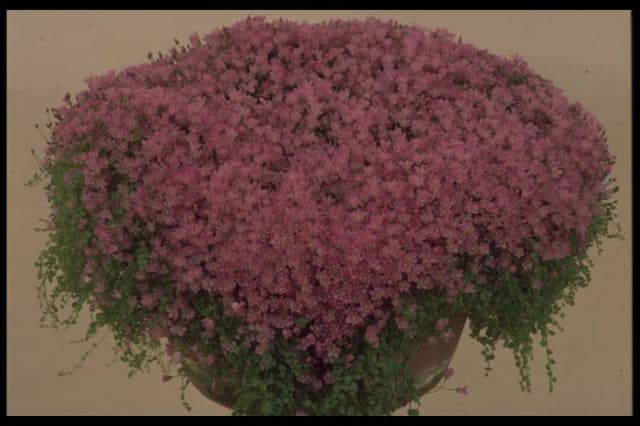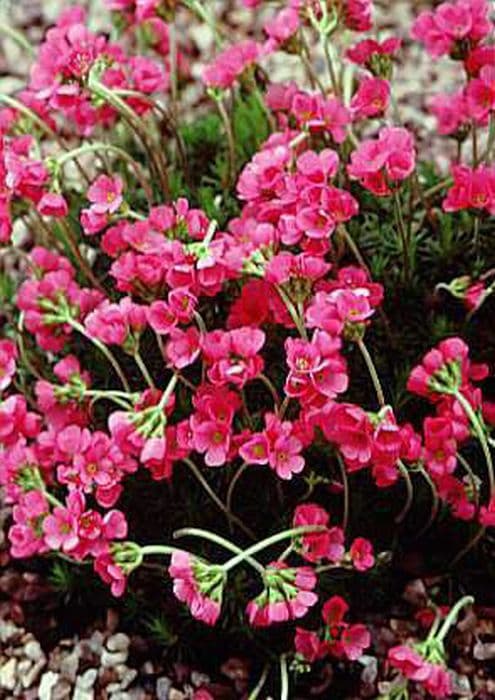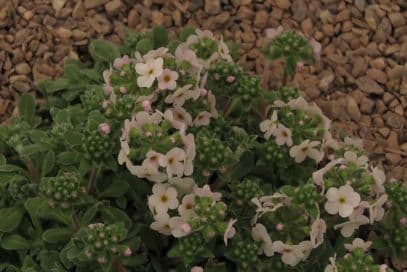Japanese Primrose Primula sieboldii 'Hana-monyo' (Co)

ABOUT
The 'Hana-monyo' variety of Primula, commonly referred to as Siebold's Primrose, is characterized by its striking flowers. These blooms feature a delightful mix of color and pattern, uniquely defining the 'Hana-monyo' designation. The flower petals are rounded and often display a two-tone color scheme, with a base of white or pale pink and a captivating overlay of intricate markings. These markings can range from spots to speckles or even brush strokes, in shades typically of pink, red, or purple. The petals are arrayed in a typical primrose formation, radiating outwards from the center to form a round, flat-faced flower. The center of the flower usually has a contrasting yellow or orange eye, which adds to its charm and draws the eye. Siebold's Primrose has a lush cluster of basal leaves that provide a verdant backdrop to the floral display. The foliage is rich green, sometimes with a slight ruffle or crinkle, which complements the delicate nature of the blossoms. During its blooming season, typically in the spring, the plant produces a vibrant display, making it a popular choice for gardeners and plant enthusiasts who wish to add a splash of color and intricate patterns to their collection. Despite the absence of dimensions in this description, it's notable that the compact growth habit of 'Hana-monyo' plants makes them suitable for a variety of garden settings or for pot culture, where their decorative blooms can be admired up close.
About this plant
 Names
NamesFamily
Primulaceae.
Synonyms
Siebold's Primrose, Japanese Primrose, Cherry Blossom Primrose.
Common names
Primula patens, Primula malacoides Franch.
 Toxicity
ToxicityTo humans
Primula sieboldii, commonly known as Siebold's primrose, is not widely recognized as a poisonous plant to humans. Generally, there are no significant reports of toxicity from ingesting this plant. While many Primula species can cause mild gastrointestinal upset if ingested in significant quantities, the specific cultivar 'Hana-monyo' does not have well-documented cases of poisoning. Therefore, consuming any part of Siebold's primrose is unlikely to cause severe symptoms, but it is always good practice to avoid eating plants that are not established as safe for consumption.
To pets
Siebold's primrose, also known as Primula sieboldii, is not typically listed as toxic to pets. There is limited information available on the specific 'Hana-monyo' cultivar, but the Primula genus in general does not have a reputation for being highly toxic to animals. If a pet ingests Siebold's primrose, there might be a risk of mild gastrointestinal upset, such as vomiting or diarrhea, particularly if consumed in large amounts. However, there are no severe toxicity symptoms commonly associated with this plant. It's important for pet owners to be vigilant and prevent their pets from ingesting any non-food plants, as individual sensitivities can vary.
 Characteristics
CharacteristicsLife cycle
Perennials
Foliage type
Deciduous
Color of leaves
Green
Flower color
Varies
Height
0.5 feet (15 cm)
Spread
0.5 feet (15 cm)
Plant type
Herb
Hardiness zones
5
Native area
Asia
Benefits
 General Benefits
General Benefits- Aesthetic Appeal: The vivid flowers of the Japanese Primrose add color and visual interest to gardens and landscapes.
- Low Maintenance: Once established, it generally requires minimal care, which is ideal for busy gardeners.
- Cold Tolerant: Adapted to cooler climates, it can survive and thrive in areas with cold winters.
- Pollinator Friendly: The blossoms attract bees and butterflies, supporting local ecosystems.
- Naturalizing: It can spread and create natural-looking drifts in the garden, giving a wildflower meadow effect.
- Seasonal Interest: Provides early spring flowers when few other plants are in bloom.
- Companion Planting: A great companion for other shade-loving plants in woodland or shade gardens.
- Edging Plant: Suitable for borders and edging paths due to its compact growing habit.
 Medical Properties
Medical Properties- Anti-inflammatory: Primula sieboldii may have components that help reduce inflammation in the body.
- Expectorant: Traditionally, some species of Primula are known to help in expelling phlegm from the respiratory tracts.
- Diuretic: It is suggested that Primula species could promote the excretion of urine, aiding in the removal of excess water and toxins from the body.
- Immunomodulatory: There is a possibility that the plant has effects on the immune system, though detailed studies are needed to confirm this property.
 Air-purifying Qualities
Air-purifying QualitiesThis plant is not specifically known for air purifying qualities.
 Other Uses
Other Uses- Artistic Inspiration: The intricate patterns of the Primula sieboldii are often used by artists and designers for creating textiles, wallpapers, and other decorative elements.
- Photography Subject: Due to its unique patterns and vibrant colors, the Primula sieboldii 'Hana-monyo' is a popular subject for photographers, particularly those specializing in macro and plant photography.
- Cultural Symbolism: In some cultures, the Primula sieboldii 'Hana-monyo' may be used as a symbol in ceremonies and festivals to represent beauty, renewal, and the changing seasons.
- Educational Tool: In botanical and horticultural studies, this plant can be used to teach about plant genetics and the breeding of flowers for particular aesthetic traits.
- Garden Design: Primula sieboldii 'Hana-monyo' can be used in shade garden designs that focus on creating visual interest with foliage and flowers in low-light areas.
- Horticultural Therapy: The cultivation of delicate plants like Primula sieboldii 'Hana-monyo' can provide therapeutic benefits, offering a sense of achievement and stress relief.
- Floristry: While not a traditional cut flower, the Primula sieboldii can be used in creative floristry, particularly in 'living' arrangements where the plant can continue to grow.
- Ikebana: The Japanese art of flower arranging, Ikebana, can use the 'Hana-monyo' variety for its significance and structured beauty in traditional arrangements.
- Ecosystem Support: When planted in gardens, Primula sieboldii 'Hana-monyo' can provide early spring nectar sources for pollinators waking from dormancy in temperate climates.
- Literary Inspiration: The unique appearance of Primula sieboldii has the potential to inspire writers and poets, finding its way into literature as a metaphor or descriptive element.
Interesting Facts
 Feng Shui
Feng ShuiThe Japanese Primrose is not used in Feng Shui practice.
 Zodiac Sign Compitability
Zodiac Sign CompitabilityThe Japanese Primrose is not used in astrology practice.
 Plant Symbolism
Plant Symbolism- Enduring Love: The Primula, often known as the Primrose, traditionally symbolizes young or eternal love, which corresponds with the springtime bloom of these flowers.
- Femininity: With its delicate and varied colors, the Primrose is frequently associated with the softness and grace often attributed to femininity.
- Renewal: As one of the early bloomers of spring, Primroses signify new beginnings, growth, and the renewal that comes with the season.
- Hope: Their bright appearance after the long winter months makes them a symbol of hope and the optimism that follows adversity.
- Protection: In some cultures, Primroses are believed to provide protection and safety, guiding souls in the afterlife, or keeping away harmful influences.
 Water
WaterThe Japanese Primrose should be watered thoroughly, allowing the top inch of soil to dry out between waterings. This may mean watering approximately once a week, but the frequency can vary depending on environmental conditions such as temperature and humidity. Ideally, use room-temperature water and slowly pour about 16 to 24 ounces around the base of the plant, avoiding wetting the foliage to prevent fungal diseases. During the growing season in spring and summer, ensure consistent moisture, while in winter, reduce watering as the plant goes into dormancy.
 Light
LightJapanese Primrose thrives in partial to full shade, making it ideal for a spot that is shielded from the harsh afternoon sun. Bright, indirect light is best, so a location under a tree or on the north side of a building can provide the optimal lighting conditions. Direct sunlight, especially during hot summer months, can scorch the delicate leaves of the plant.
 Temperature
TemperatureJapanese Primrose prefers cooler temperatures, ideally between 60°F and 75°F. The plant can survive minimum temperatures down to 30°F for short periods, but prolonged exposure to freezing conditions is harmful. The ideal temperature range ensures vibrant growth and flowering, so try to maintain this range, especially during the blooming period.
 Pruning
PruningPruning of the Japanese Primrose is primarily for deadheading spent blooms to encourage further flowering and for removing dead or yellowing leaves to maintain the plant's appearance. It's best to prune in late fall after flowering has finished or in early spring before new growth begins. This can be done yearly to promote healthy growth and ensure a tidy form.
 Cleaning
CleaningAs needed
 Soil
SoilJapanese Primrose 'Hana-monyo' thrives in moist, well-draining soil rich in organic matter with a pH range of 5.5 to 7.0. A mix consisting of peat, garden loam, and perlite or sand is ideal, ensuring good aeration and moisture retention.
 Repotting
RepottingJapanese Primrose 'Hana-monyo' should be repotted every one to two years to replenish the soil and accommodate root growth. It's best to repot in the early spring before the plant resumes active growth.
 Humidity & Misting
Humidity & MistingJapanese Primrose 'Hana-monyo' prefers a high humidity environment, ideally around 60-70%. To maintain optimal humidity, it can benefit from being placed in a humidity tray or in a naturally humid area such as a bathroom.
 Suitable locations
Suitable locationsIndoor
Place in bright, indirect light with high humidity.
Outdoor
Partial shade, consistently moist soil, protect from harsh sun.
Hardiness zone
4-8 USDA
 Life cycle
Life cyclePrimula sieboldii 'Hana-monyo', commonly known as the Japanese woodland primrose, begins its life cycle when the seeds are sown in well-draining, moist soil and germinate, usually in the spring. The seedlings develop into rosettes of foliage and, as they mature, they form a clump with heart-shaped, sometimes toothed leaves. After the first or second year, in late spring to early summer, the plant produces clusters of delicate flowers on stems that rise above the foliage, displaying intricate patterns that give the 'Hana-monyo' cultivar its name. Following pollination, the plant sets seed, which can be collected for propagation or allowed to self-sow. In the winter, the above-ground parts of the plant die back, while the rootstock remains dormant underground. With the onset of the next spring, the plant will resume growth, starting the cycle anew with fresh foliage and subsequent flowering.
 Propogation
PropogationPropogation time
Spring-Early Summer
Primula sieboldii 'Hana-monyo', commonly known as Siebold's Primrose, is best propagated through division, which allows the plant to maintain its variegated patterns. The most appropriate time for division is in the early spring or immediately after flowering, when the plant is beginning to enter a period of active growth. To propagate by division, gently remove the plant from its pot or garden location and carefully separate the clump into smaller sections, ensuring that each new section has a portion of root and a few leaves. Replant the divisions at the same depth they were growing previously, spacing them about 6 to 12 inches (about 15 to 30 centimeters) apart to allow enough room for growth. Water the new divisions well and maintain consistent moisture while they establish. With the right conditions, these divisions will grow into mature plants that are identical to the parent.









